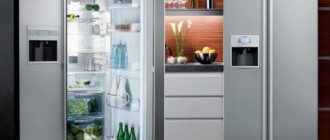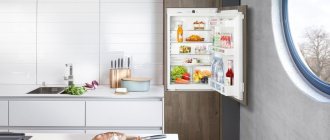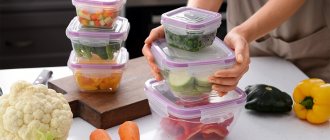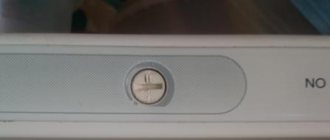Once upon a time, refrigerators were designed according to the principles of physics - heavy cold air fell down through the lattice shelves, lowering the temperature of the entire chamber. Today everything has become more complicated; not everyone understands where the coldest place in the refrigerator is.
The early principle of the refrigerator was to push heavy cold air down through lattice shelves, but now the shelves are glass and the circuit has become more complicated.
With the advent of two-chamber and three-chamber modifications, where the freezer is at the bottom and the shelves are glass, not every housewife is able to properly distribute food. The issue of storing food in the refrigerator should be given enough attention to extend the shelf life of food.
What determines the temperature distribution in the refrigerator?
When preparing food for use, it is important to know where the coldest places in the refrigerator are.
Many families have arguments about where it is colder in their refrigerator - at the top or bottom. There are no clear instructions on this topic in the instructions, and everyone arranges bags and pots at their own discretion. It is not customary for some owners to purchase a lot of food, and where the warmest and coldest places are is determined empirically. For those who make purchases for future use, this question is most relevant.
Regardless of the instructions on the packaging and the appearance of the products, it is important to follow the unshakable storage rule. It is not recommended to keep food in the refrigerator for more than 3 months, especially if it has been opened.
It is not always possible to determine whether the inside of a powerful unit is cool enough if its temperature is adjusted correctly. When the first dishes do not freeze on the top shelf, it seems that it is equally cold everywhere.
Always check the cold control settings.
On the other hand, constantly freezing food is the norm for some. In this way, they “expand” the capabilities of a crowded freezer, trying to store meat and fish on the coldest shelf at the back wall.
Meat and fish are stored on the coldest shelf against the wall.
A refrigerator filled to capacity not only prevents food from cooling properly. Energy consumption increases to maintain a given level - no higher than +4-5°C. Special sensors and relays are responsible for the temperature maintenance function. If the door is often opened and it takes a long time to choose what to eat, the cheeses and yoghurts standing on it will quickly become unusable.
A refrigerator that is overloaded with food will not be able to function fully.
The temperature in the refrigerator, or Where is its coldest place?
On the Internet you can come across a huge amount of conflicting information and controversy on this topic.
Some argue, citing the laws of physics, that it is coldest at the bottom. And someone, no less convincingly, proves the opposite. Let's try to figure out where the coldest place in the refrigerator is? It is useless to unequivocally state this or that with foam at the mouth. The laws of physics, of course, have not been canceled and cold air still sinks and warm air rises. But it's not that simple! The temperature in different parts of the refrigerator compartment largely depends on the design features of the refrigerator itself.
Single chamber
As you know, refrigerators mainly come in two types: two-chamber and single-chamber. In single-chamber freezers, the freezer is usually located at the top and therefore, contrary to popular belief, it is coolest on the top shelf. The fact is that cold air from the evaporator of the freezer, falling down, passes rather slowly through the shelves with food and gives them cold. In fact, the shelves are partitions that prevent normal air circulation, so unimpeded convection occurs only between the freezer and the top shelf.
Modern single-chamber refrigerators have a special valve in the freezer tray, by opening and closing which you can additionally influence the degree of cooling of food in the main chamber.
Therefore, it is recommended to store meat and sausages on the upper levels directly under the evaporator of the freezer. Prepared meals and dairy products should be kept on the middle level, and drinks below. For vegetables and fruits, there is a special pull-out tray at the bottom under glass, which allows you to maintain a certain humidity in the tray.
There are refrigerators that do not have freezers. They are commonly used in shops, hotels, and when transporting food and drinks that need to remain cold. In such models, the cooling function is performed by a special circuit in which subzero temperatures are maintained. In this case, it will be coldest near the walls of the chamber and below.
Double chamber
In two-chamber refrigerators, everything is arranged differently, and the temperature does not depend in any way on the location of the freezer. They have separate refrigerator and freezer compartments and each has its own evaporator. The evaporator takes heat from the object being cooled and transfers it to the refrigerant, which evaporates in the chamber channels. Therefore, the coldest place is located next to the evaporator openings, usually at the back wall and at the bottom of the compartment, due to natural air circulation.
Two-chamber refrigerators with a forced convection system are equipped with special fans that ensure uniform distribution of cold air throughout the entire volume of the chambers. In this case, the temperature difference at different levels depends only on the location of the fans and ventilation openings.
With forced convection, intense air flow over products leads to dehydration. Therefore, they should be stored in airtight containers.
The instruction manual usually clearly states the order in which food should be placed on the shelves, and sometimes even the levels inside the refrigerator compartment are marked with appropriate symbols. If the instructions don’t even say a word about this, then you can simply take a small room thermometer and measure the temperature on all shelves yourself to eliminate all doubts.
Conclusion
One thing is absolutely certain: the coldest place in any refrigerator is always located in the depths of the refrigerator compartment, closer to the back wall, and the warmest is on the door shelves, since they are most often exposed to the external temperature when opened.
To learn more about how a household refrigerator works, watch the video.
Where in the refrigerator is it colder?
To avoid being mistaken about which shelf in your refrigerator is colder, it is important to find a source of low temperature. Cold and warmer locations may vary depending on the design and brand of unit. Visually, you can also determine where it is coldest - there is ice or artificial frost.
The location of cold and warmer shelves in the refrigerator depends on the brand and design of the refrigerator.
Inside an overloaded unit, full air circulation is disrupted, cold and warm air masses are poorly mixed.
Initially, the designers proposed placing the cold source at the top so that the heavy air would “flow” down. Modern units have partitions, valves and doors that can isolate the microclimate inside a small compartment. Therefore, the temperature in different places can vary by several degrees.
Warm air entering the refrigerator when the door is open changes the temperature in different zones differently.
Single chamber refrigeration units
A characteristic feature of single-chamber models remains the location of the freezer. It is located in the upper part of the common chamber, therefore, it is coldest on the adjacent shelves. The subzero temperature separation evaporator produces cold.
In single-compartment refrigerator-freezers, the coldest places are on the shelf under the freezer.
There are also single-chamber chest freezers used for transporting and selling products. For some time, small refrigerators without a freezer were also produced, in which the cooling was from the rear wall. The temperature there is approximately the same, but it is not recommended to store food there for a long time.
In refrigerators without a freezer, the coldest places are near the back wall.
The unique design of a refrigerator with one chamber
The simplest device is found in old single-chamber models. They are distinguished by lattice shelves and the proximity of the common space to the freezer. The upper part is always colder; perishable foods should be stored here.
The simplest device is equipped with old single-chamber refrigerators.
However, if we consider different models, their temperature conditions may differ significantly. This largely depends on the material of the shelves and the overall occupancy of the space. Solid surfaces made of glass and plastic inhibit the spread of cold.
Which shelves are the coldest in single-chamber refrigerators?
The coldest place is at the top, where the cooling source is located. It is better to lay out meat products, fish and semi-finished products here.
In single-chamber refrigerators, the top shelves are colder.
In the lower part, where it is warmest, there may be vegetables and fruits that spoil from hypothermia. The sign is red spots; pathological microflora often develops in these places.
You should not risk the health of your household. It is better to dispose of vegetables, mushrooms and fruits if they are expired or have signs of rot. They can be a source of mold and mildew for safer food.
Review your inventory as often as possible. It is advisable to cook products with signs of damage as quickly as possible, cutting off areas with flaws.
How is the temperature distributed in a single-chamber refrigerator?
In those refrigeration units where there is only one chamber, the freezer compartment is located in the upper part. The refrigerant moves either through special capillaries or along the walls of the chamber. Thanks to this, the temperature set for all compartments is maintained.
The coldest area in it is considered to be the shelf located under the freezer compartment. The temperature in it is as close as possible to zero degrees.
This distribution of cold is explained quite simply. The evaporator is located as close as possible to the indicated shelf. In the process of air circulation, cold currents take away heat from the shelves located nearby.
The temperature on the lower shelves of the cooling compartment may be slightly higher than that located under the freezer. Can range from 1 to 7 degrees. These differences are explained by the material from which the shelves are made. If they are lattice type, then air passes through them more easily. If it is made of glass or plastic, then the air moves inside the chamber worse.
The flow exchange is also affected by the load on the shelves with products. The more there are, the warmer the air will be on the shelf farthest from the freezer.
Double chamber refrigeration units
Of course, the invention of two-chamber refrigerators was a new breakthrough in this niche of kitchen equipment. Having such a unit, you don’t have to worry about the food above freezing. Or that food will spoil if placed on the wrong shelf.
The invention of two-chamber refrigerators greatly improved food storage.
The only caveat is that the door is often opened, a place where you should not put perishable food. It is warmest here, since the “microclimate” is unstable, however, as in single-chamber models. When opened, the delicate temperature balance is reset, so you can only put fresh herbs, eggs, hermetically sealed sauces and drinks here.
The unique design of a refrigerator with two chambers
In modern two-chamber models, everything is thought out to the smallest detail. The freezer and the common chamber function separately; each part has its own evaporator, which provides the necessary cold.
A two-chamber refrigerator is a complex system where conditions are created for the best preservation of food.
The coldest place is at the back wall, near the evaporator holes.
Unlike single-chamber options, the lower part of the compartments is also cold, since the heavy air mass falls down unhindered.
Which shelves are the coldest in two-chamber refrigerators?
New models with forced convection ensure uniform circulation of cool currents. All compartments, even in a crowded refrigerator, will have the same temperature. But it is worth taking into account that during such storage, products quickly lose moisture. They should only be stored in airtight packaging or tightly sealed containers.
One great option for storing food is tightly sealed containers.
If we talk about the freezer, then everything is ambiguous here too. It is warmer on the top shelf than below, within 10 – 14°C below zero. Frozen fruits and berries, mushrooms and seafood are placed here.
Fish is stored on the coldest shelf.
The coldest shelf is located at the bottom, this is the place for cutting meat, offal, fish and poultry carcasses.
Rules for storing food in the refrigerator
In the main compartment there are several shelves where everything is usually stored, complicating natural convection - the cold sinks down, displacing warmer air.
Tightly packed foods do not allow air to circulate.
Bags and containers should not be folded tightly; there should be gaps between them for cool circulation.
Storing products in the positive chamber, where the temperature is set by a relay regulator from 0 to +5°, has its own characteristics.
Storing food in the refrigerator at temperatures from 0 to +5°.
The coldest place is on the plane adjacent to the freezer or on the back wall. It is correct to put meat products away, especially if it is chilled chicken stored without freezing. As a rule, it is prepared within 3 days.
Non-frozen chicken is stored at the back wall.
You cannot place cheese, cold cuts and dairy products on the same shelf with meat. The exception is properly packaged food - in tightly closed containers, containers and sealed bags. Milk, meat and fish dishes are also stored on the coolest shelves.
Dairy products are stored on cooler shelves.
Greens, vegetables and fruits are often stored in the lower compartment, but they need to be laid out separately. The unpleasant onion smell can make bananas or apricots unpleasant, especially for children. If there are few vegetables in the apartment, and you intend to cook them soon, it is better to keep them in nets on the balcony or in a cool pantry, away from shelves with perishable foods.
Vegetables stored in the refrigerator stay fresh longer.
Temperature distribution
You should also take into account the fact that in the refrigerator compartment the cold is distributed differently. Colder zones are suitable for storing products with a short shelf life, and warmer ones for vegetables and fruits.
Warm zone
The door is the warmest zone , where the temperature ranges from +5º to +10°. That is why ketchup and mayonnaise, various sauces, and butter are usually placed in the door. It is not advisable to store milk and eggs in such a warm place, although in most models there is a place for eggs on the door.
On the upper shelves the temperature ranges from +3º to +5° and is always slightly warmer than on the lowest shelf, since heat always rises to the top. On the upper shelves they usually store: sausages, bread, vegetables, cheeses. It is not recommended to store in the following places: milk, poultry, eggs, fish.
In special boxes for storing vegetables, the temperature reaches +8º.
Cold zone
Almost every modern refrigerator has a freshness zone (also called the “zero zone”) , where the temperature is about 0 ° C. This zone is specially designed for storing fresh herbs, vegetables and fruits.
Since the back of the refrigerator is closest to the cooling elements, it is also the coldest.
On the lower shelves the temperature stays around +2º, as all the warm air rises.
It is in these places that meat, milk, fish and other perishable products are stored.
Tips for properly storing food in the refrigerator
Odors in any refrigerator compartment tend to mix. Food that has been stored for a long time does not smell like fresh food. Expired products do not always “signal” with a smell, but pathogenic microflora is already beginning to develop.
Always make sure there are no expired foods in the refrigerator.
Review products with expiration dates frequently.
Pears and apples, if there are only a few of them, should not be placed in the refrigerator. It is suggested that the fruits be washed and displayed in a vase (on a tray) in the living room or on the dining table. Peaches, apricots, plums and grapes are best stored on the warmest shelves of the refrigerator.
Fruit is stored on the warmest shelves of the refrigerator.
Zucchini and squash, watermelons and melons, and other melons can be stored for up to a week outside the refrigerator, and they can be cooled before slicing. Mushrooms and such “capricious” vegetables as cucumbers, tomatoes, eggplants and bell peppers need refrigerated storage. But even when frozen, they also spoil, so you can’t put them on top of cold shelves near the freezer.
Vegetables should be stored refrigerated.
In places with a “temperate climate” with temperatures from +3 to +6°C, you can safely leave pots with first and second courses, a bowl of jellied meat. Nearby there may be butter and lard, smoked meats, cheeses and sweets, open preserves and sausages.
Sausages and smoked meats can be stored at temperatures from +3 to +6°C.
General advice from nutritionists and naturopaths is that if you live near a supermarket, do not stock up on a lot of food for future use. On the way home from work, it is better to buy dairy products and semi-finished products, sliced and fresh herbs for 1-2 days.
If possible, it is better to purchase products for 1 - 2 days.
Many dishes, including cottage cheese and meat products, do not require long-term storage. No matter where they are placed, they have a short shelf life - no more than 3 days. Cold shelves, foil, parchment paper and polyethylene will not protect perishable food from the development of pathogenic microflora.











